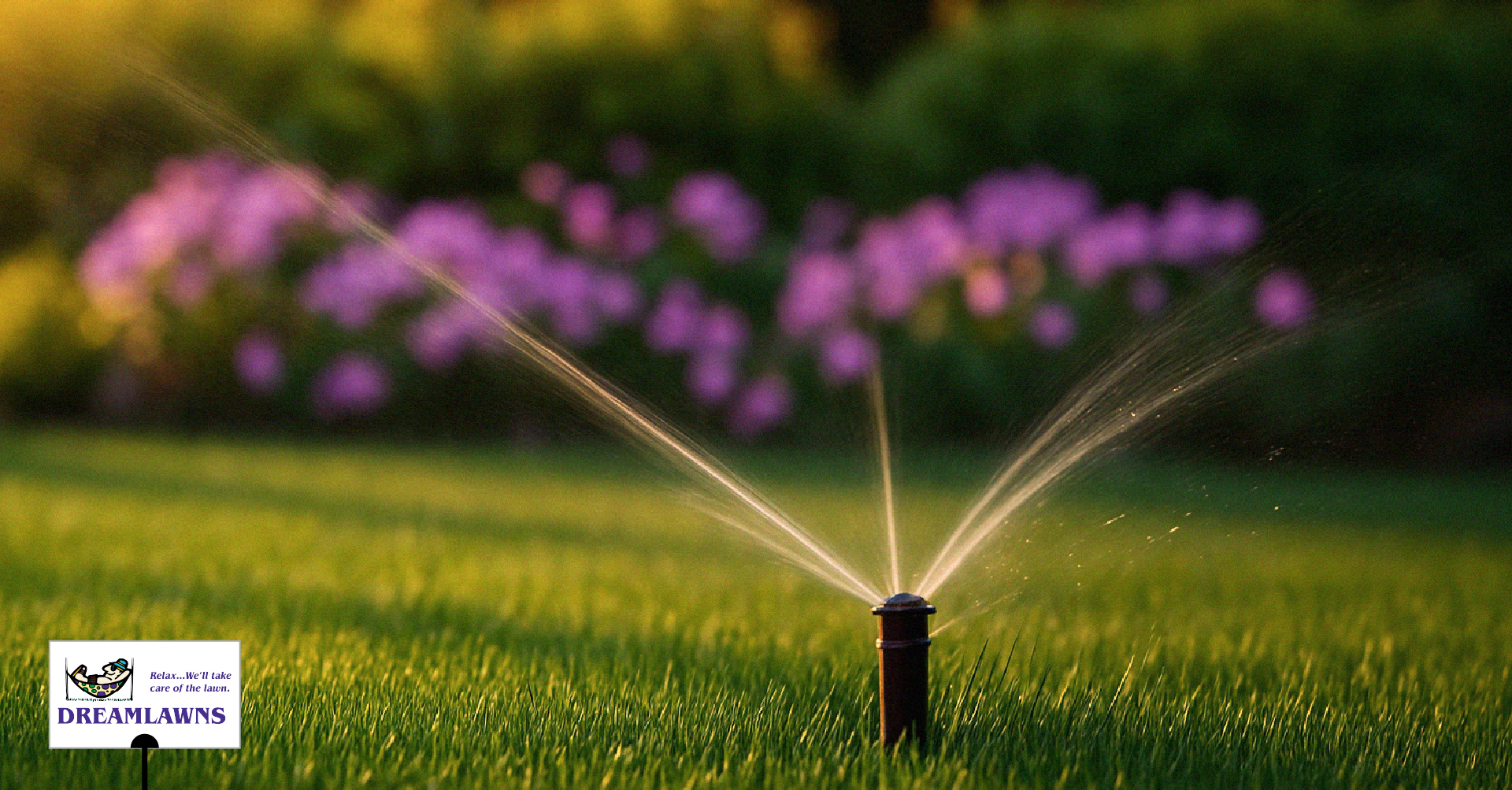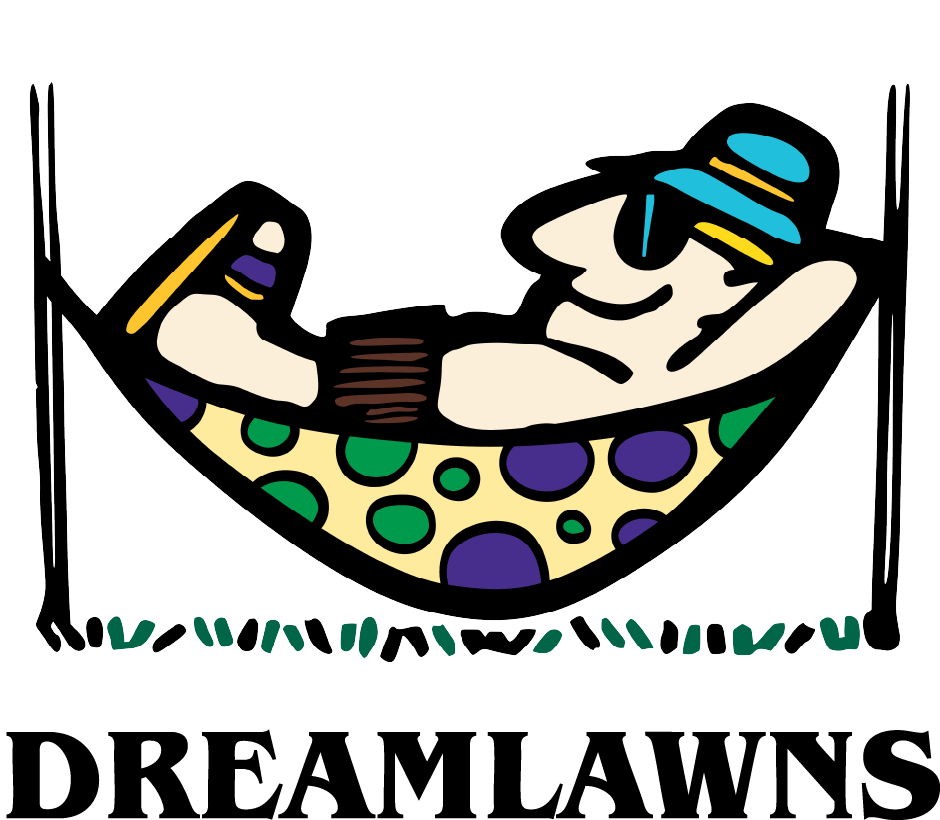
As the lush growth of spring begins to taper off, Virginia Beach lawns face a new set of challenges: scorching temperatures, thick humidity, and increased wear from backyard barbecues, kids, pets, and foot traffic. Summer can be one of the most stressful seasons for your lawn, and without the right preparation, even healthy turf can quickly decline.
Unlike spring, when grass is actively growing and conditions are ideal for thickening and repair, summer requires a more protective, preventative mindset. You’re not just growing your lawn, you’re helping it endure.
How can you shift your lawn care strategy from growth to survival? Let’s break down how to adjust your mowing and watering habits, why fertilization needs change as temperatures rise, and how Dreamlawns prepares your lawn to handle disease, pests, and the pressures of summer activity, before problems begin.
Adjusting Mowing and Watering for Summer Conditions
During spring, mowing and watering help fuel growth. In summer, they become tools for protection and preservation. Properly adjusting these practices is one of the most effective ways to help your lawn withstand seasonal stress.
Raise Your Mowing Height
As temperatures rise, your mowing strategy should change. Raising your mower blade helps your lawn:
- Retain more moisture by providing shade to the soil
- Reduce heat stress on the grass crown (the most sensitive part of the plant)
- Grow deeper roots for better drought tolerance
For Fescue lawns, keep your mowing height right around 4 inches during the summer months. Taller grass also naturally crowds out weeds and reduces the chances of heat-related damage.
Switch to Deep, Infrequent Watering
One of the most common mistakes homeowners make in summer is frequent, shallow watering, which encourages weak, surface-level roots and creates an ideal environment for fungal diseases. Instead:
- Water deeply (about 1 to 1.5 inches per week)
- Break this into 1 or 2 sessions per week rather than daily watering
- Water early in the morning to minimize evaporation and reduce disease risk
This approach trains your grass to send roots deeper into the soil, improving drought resistance and making your lawn more resilient under pressure.
Fertilization During Summer: Less Is More
Fertilization plays a key role in lawn health, but when it comes to summer, timing and moderation are everything. Applying too much fertilizer, especially high-nitrogen blends, during the heat of summer can do more harm than good.
Why Over-Fertilizing in Summer Is Risky
During periods of high heat, your lawn is under stress. Heavy fertilization encourages top growth when the grass is already working hard just to survive. This overstimulation:
- Diverts energy away from root development
- Increases the risk of burning the lawn, especially during drought
- Makes turf more susceptible to fungal disease, especially when paired with excess watering
The Importance of Balanced, Slow-Release Nutrients
Instead of aggressive feeding, summer fertilization should focus on maintenance and resilience. That means:
- Using slow-release or controlled-release fertilizers that deliver nutrients gradually
- Choosing blends lower in nitrogen and higher in potassium to support stress tolerance and disease resistance
- Applying with precision and care, only when the lawn can actually benefit
How Dreamlawns Adjusts Fertilization Seasonally
At Dreamlawns, we custom-blend our fertilizers to suit the season, your turf type, and local weather conditions. During summer:
- We scale back high-nitrogen treatments
- We shift toward blends that support root health and recovery
- We make adjustments based on your soil test results and overall lawn condition.
Fertilization is still important in summer, but it has to be part of a broader, carefully timed plan.
Combating Summer Disease and Insect Pressure
Summer isn’t just about heat and drought, it’s also the peak season for lawn diseases and damaging insect activity. These stressors often go unnoticed until significant damage has already occurred, making prevention and monitoring critical.
Common Summer Lawn Diseases in Virginia Beach
Brown Patch: A fast-spreading fungal disease that thrives in hot, humid conditions and especially affects Tall Fescue. It creates circular patches of brown, thinning grass and can devastate a lawn in weeks.
Gray Leaf Spot: Often confused with drought stress, this disease causes blades to wither and die, leaving behind irregular dead zones.
Both diseases are made worse by:
- Nighttime watering or excessive leaf wetness
- Poor airflow
- Overfertilizing with nitrogen during hot weather
Insects That Threaten Summer Turf
Grubs: These beetle larvae feed on grass roots, leading to brown, spongy patches that lift easily from the soil.
Fall Armyworms: Especially active later in the summer, they can strip a lawn bare in days.
Chinch Bugs: These pests suck moisture from blades of grass, causing drought-like symptoms and rapid turf loss.
Managing Foot Traffic and Soil Compaction
Summertime often means more time outside, barbecues, kids playing, pets running around, all of which can take a serious toll on your lawn. Increased foot traffic, especially when combined with heat and drought, leads to soil compaction, turf thinning, and bare patches that open the door for weeds and disease.
How Foot Traffic Impacts Lawn Health
Repeated pressure from walking, playing, or outdoor furniture can:
- Compact the soil, making it harder for air, water, and nutrients to reach the roots
- Crush grass blades and crowns, especially when turf is already heat-stressed
- Create localized thinning, which is easily exploited by aggressive weeds like crabgrass or Dallisgrass
These worn-down areas are not just cosmetic, they affect the overall performance and recovery of your lawn throughout the season.
Short-Term Tips to Minimize Summer Damage
- Rotate high-use areas when possible to prevent heavy wear in one spot
- Use stepping stones or mulch paths in consistently trafficked zones
- Keep mower blades sharp to avoid tearing already stressed turf
- Raise mowing height to reduce impact on grass crowns and root zones
Aeration: The Long-Term Remedy for Compaction
While heavy aeration isn’t recommended during peak summer, fall core aeration is essential for reversing summer compaction. Aeration:
- Relieves pressure on the root zone
- Allows moisture and nutrients to penetrate compacted soil
- Creates better conditions for fall overseeding and turf recovery
Dreamlawns includes aeration as part of our year-round strategy, because we know summer stress doesn’t just happen above the soil, it’s also about what’s happening beneath it.
Dreamlawns’ Summer Strategy: Proactive, Not Reactive
At Dreamlawns, we understand that by the time most homeowners notice summer damage, it’s already too late for quick fixes. That’s why we focus on proactive, seasonally tailored care, designed to help your lawn withstand stress before it becomes visible.
We Adjust With the Season, Not Against It
As we transition from spring to summer, we don’t just keep doing the same treatments on autopilot. Instead, we:
- Adjust fertilization formulas to avoid overstimulating growth during heat stress
- Time disease and insect control based on regional cycles, not just the calendar
- Tailor mowing and watering advice for each lawn, depending on its turf type, soil condition, and exposure
This hands-on, flexible approach ensures your lawn is supported throughout the summer, not just treated after the damage is done.
Local Expertise, Personalized Care
Because we serve Virginia Beach and surrounding areas exclusively, we know what your lawn is facing, from microclimate variations to common pest outbreaks. Our team doesn’t just apply products, we assess, adapt, and adjust based on what’s happening in your yard right now.
Whether you’re managing cool-season Fescue or a warm-season turf like Bermuda, Dreamlawns provides:
- Customized treatment schedules
- Responsive support during summer problem periods
- Seasonal strategies that link summer care directly to fall recovery
We don’t just protect your lawn in summer, we position it to bounce back stronger in fall.
Prepare Your Lawn For Summer With Dreamlawns
Summer brings some of the toughest conditions your lawn will face all year: intense heat, high humidity, disease pressure, insects, and the wear and tear of daily life. But with the right preparation, your lawn doesn’t have to suffer. In fact, with a smart, proactive approach, it can come through the summer looking strong and ready to thrive in the fall.
By adjusting your mowing and watering habits, fine-tuning your fertilization plan, and protecting your turf from pests and disease, you can build a lawn that not only survives the season but sets the stage for long-term success.
At Dreamlawns, we’re here to help you navigate this transition with customized care, expert timing, and honest guidance. Whether you’re looking to strengthen your Fescue or maintain a healthy warm-season lawn, our team is ready to help you take control before summer stress sets in.
Ready to prepare your lawn for the season ahead? Contact us today and let’s create a summer care plan that keeps your lawn healthy, resilient, and beautiful all year long.
Dreamlawns provides superior lawn care service to Virginia Beach & Chesapeake VA residents.




